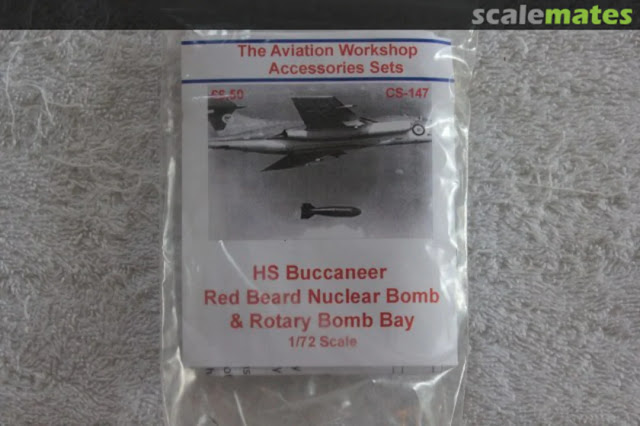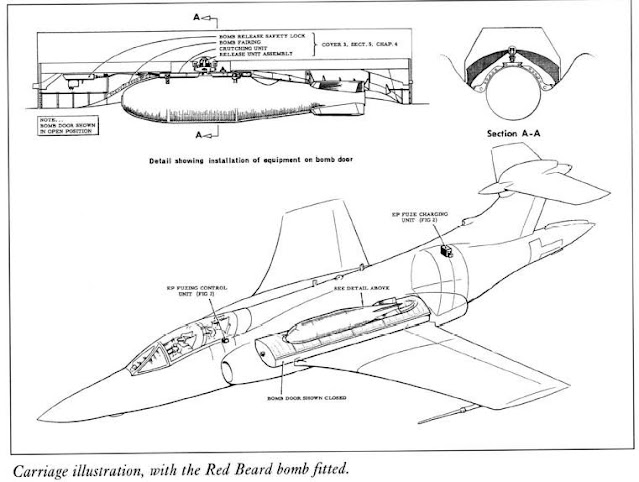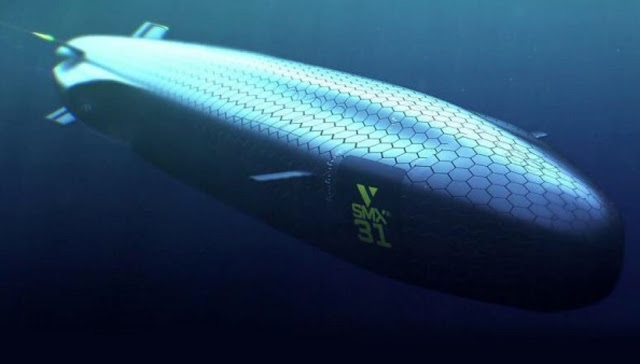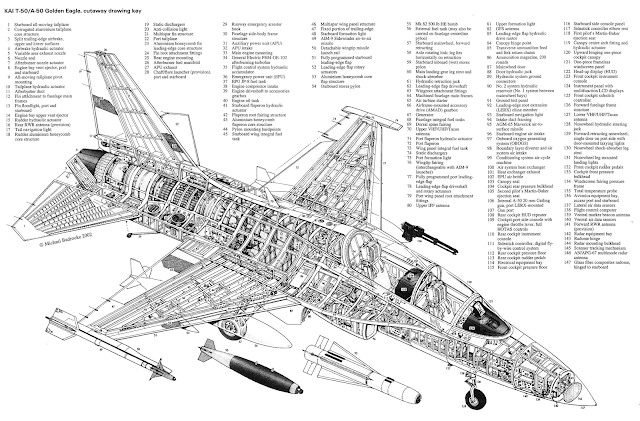La Red Beard è stata la prima arma nucleare tattica britannica e fu utilizzata dai bombardieri V della Royal Air Force (RAF), e dai Blackburn Buccaneers, Sea Vixens e Supermarine Scimitar della Royal Navy (RN) Fleet Air Braccio (FAA). Fu sviluppata in base al requisito operativo 1127 (OR.1127), e introdotta in servizio operativo nel 1961-1962. È stata sostituita dalla bomba WE.177 all'inizio degli anni '70 e fu stato ritirato nel 1971.
Design
La Red Beard era un'arma a fissione non potenziata che utilizzava un nucleo composito (nucleo misto nella terminologia britannica dell'epoca). Il nucleo composito utilizzava sia plutonio per armi che uranio 235; ciò doveva ridurre al minimo il rischio di pre-detonazione che era una caratteristica dei progetti interamente in plutonio di quel periodo con rese superiori a 10 kilotoni (kt). Un ulteriore vantaggio del nucleo composito era un uso più economico del materiale fissile. Il progetto fu testato due volte durante la serie di prove nucleari dell'Operazione Buffalo a Maralinga in Australia, la prima il 27 settembre 1956: un'esplosione di 15 kt, dopo di che il fungo atomico risultante raggiunse un'altezza di 11.430 metri, e di nuovo il 22 ottobre 1956. Sebbene il concetto di design della Red Beard fosse simile a quello della testata Blue Danube, un mezzo innovativo di implosione significava che le sue dimensioni complessive potevano essere notevolmente ridotte.
Le sue misure erano:
- 3,66 metri di lunghezza,
- 0,71 metri di diametro,
- peso di circa 794 kg.
Sono state prodotte due versioni: la Mk.1 , con una resa di 15 chilotoni, e la Mk.2, con una resa di 25 chilotoni.La Mk.2 era disponibile in due varianti, la No.1 usata dai bombardieri ad alta quota e la variante No.2 che era intesa per la consegna a basso livello, e la sua "over-the-shoulder" variante denominata Low Altitude Bombing System (LABS).
Le designazioni di servizio della Royal Air Force e della Royal Navy di Red Beard erano:
- Bomba, aereo, HE 2.000 libbre MC Mk.1 No.1
- Bomba, aereo, HE 2.000 libbre MC Mk.1 No.2
- Bomba, aereo, HE 2.000 libbre MC Mk.2 No.1
- Bomba, Aereo, HE 2.000 lb MC Mk.2 No.2,
Con un peso di circa 794 chilogrammi, la Red Beard era considerevolmente più leggera della designazione ufficiale di servizio da 910 kg, basata sui requisiti tecnici originali.
Un miglioramento significativo rispetto al predecessore Red Beard, il Blue Danube, fu nella fornitura di energia elettrica per il meccanismo di sparo delle bombe e per la fusione dell'altimetro radar. La Blue Danube utilizzava batterie al piombo-acido da 6 volt che erano inaffidabili e dovevano essere installate all'ultimo minuto prima del decollo. C'erano anche potenziali rischi associati a scariche elettriche "vaganti" ai meccanismi di sparo che avrebbero potuto portare a detonazioni accidentali. La Red Beard utilizzava due turbine ad aria compressa situate nel muso, dalle quali non potevano esserci scariche vaganti prima del rilascio della bomba. La presa d'aria era posizionata nel naso estremo. Fino al rilascio della bomba, l'arma riceveva energia elettrica dall'aereo per il riscaldamento e il preriscaldamento delle spolette del radar.
Come la Blue Danube, il diametro del corpo a 0,71 metri era maggiore di quanto fosse desiderabile rispetto alla lunghezza complessiva di 3,66 metri. Per compensare questa rigidità e stabilizzare rapidamente la bomba dopo il rilascio, la Red Beard era dotata di pinne caudali estraibili che venivano attivate pneumaticamente, innescate da un cordino attaccato all'aereo.
Come con la Blue Danube, le spolette erano composte da due spolette radar attivate da un "cancello" barometrico dopo il rilascio. Il gate barometrico assicurava che le spolette del radar fossero trasmesse solo negli ultimi secondi di caduta libera, a un'altezza calcolata, e questa tecnica riduceva al minimo la possibilità che le contromisure radar disattivassero le spolette del radar. C'erano contatti di riserva e spolette per garantire la distruzione delle bombe in caso di accensione irregolare.
Nessuna delle varianti consentiva l'armamento in volo del nucleo fissile. Il nucleo veniva inserito prima del decollo, in un processo denominato "caricamento dell'ultimo minuto". Per gli aerei trasportati da portaerei, l'atterraggio con l'arma armata era vietato e l'aereo sarebbe stato invece deviato su una base aerea costiera. Sebbene la Royal Navy richiedesse che il suo velivolo Sea Vixen fosse omologato per il trasporto della Red Beard come "assicurazione" contro i ritardi nello sviluppo del Blackburn Buccaneer, il Sea Vixen non fu mai schierato nel ruolo di attacco nucleare. I primi modelli erano soggetti a gravi limitazioni ambientali, specialmente quando venivano caricati sugli SCIMITAR della Royal Navy sui ponti delle portaerei esposti nelle acque settentrionali. Le varianti Mk.2 erano progettate meglio per resistere a condizioni estreme e, a parte la differenza di resa, questa era la principale differenza.
Quando la bomba veniva lanciata da un lancio di bombe a basso livello, l'aereo si trovava quasi sempre a un'altitudine inferiore a quella dello scoppio; quindi, in effetti, la bomba non veniva realmente "sganciata", ma rilasciata verso l'alto in una traiettoria balistica, per esplodere all'altitudine richiesta.
Servizio
Le scorte della Royal Air Force di Red Beard per le forze di Canberra e V-bomber erano in totale 110. Di queste, quarantotto furono dispiegate per rispettare gli impegni del Regno Unito nei confronti della Central Treaty Organization (CENTO), quarantotto furono schierate a Singapore per rispettare gli impegni assunti dall'Organizzazione del Trattato del Sud-Est asiatico (SEATO) e il resto nel Regno Unito. Si ritiene che le scorte della Royal Navy, dai documenti archiviati declassificati, al totale di trentacinque armi, siano state condivise tra cinque portaerei e le infrastrutture di rifornimento e revisione a terra. Si pensava che i vettori avessero ciascuno una capacità di stoccaggio con aria condizionata per cinque armi Red Beard.
Prima che il nome in codice Barba Rossa fosse emesso nel 1952, nei documenti ufficiali veniva spesso fatto riferimento come 'bomba del giavellotto', perché originariamente era stato concepito come un'arma per il 'bombardiere Javelin ad ala sottile', un derivato per tutte le stagioni Gloster Javelin. La designazione "bomba marcatrice bersaglio" era un eufemismo usato per mascherare la natura della bomba, in modo che le sue dimensioni, i suoi pesi ecc. potessero essere distribuiti ai progettisti di aeromobili e attrezzature aeronautiche, senza compromettere la sicurezza.
Venne sostituita dall’ordigno WE.177 all'inizio degli anni ’70.
John Dolphin
Mentre il capo ingegnere presso l' Atomic Weapons Research Establishment (AWRE), Aldermaston, John Dolphin, CBE ha lavorato al meccanismo di innesco della barba rossa. Successivamente, nel luglio 1959, Dolphin richiese un ex-gratia premio finanziario per il suo lavoro sull'arma; ma tale premio fu rifiutato. La sua affermazione era che, sebbene non fosse il suo lavoro farlo, aveva inventato il dispositivo "Rotary Hot Line" che alla fine divenne il grilletto per la bomba Red Beard (e che fu utilizzato in tutte le successive bombe termonucleari). Affermò inoltre che la sua invenzione aveva posto fine alla situazione di stallo nel soddisfare le specifiche e che doveva superare la "seria opposizione" contro gli scienziati senior il cui lavoro includeva il brief per la sua invenzione. La sua richiesta è venne rifiutata in quanto "capo ingegnere" e ciò rientrava nell'ambito delle sue funzioni.
ENGLISH
Red Beard was the first British tactical nuclear weapon. It was carried by the English Electric Canberra and the V bombers of the Royal Air Force (RAF), and by the Blackburn Buccaneers, Sea Vixens, and Supermarine Scimitars of the Royal Navy's (RN) Fleet Air Arm (FAA). Developed to Operational Requirement 1127 (OR.1127), it was introduced in 1961, entered service in 1962. It was replaced by the WE.177 in the early 1970s and was withdrawn in 1971.
Design
Red Beard was an unboosted fission weapon that used a composite core (mixed core in British terminology of the time). The composite core used both weapons-grade plutonium and weapons-grade uranium-235, and was intended to minimise the risk of pre-detonation that was a feature of all-plutonium designs of that period with yields larger than 10 kilotons (kt). An added benefit of the composite core was a more economical use of fissile material. The design was tested twice during the Operation Buffalo series of nuclear trials at Maralinga in Australia – first on 27 September 1956: a 15 kt explosion, after which the resulting mushroom cloud rose to a height of 11,430 metres (37,500 ft), and again on 22 October 1956. Although the design concept of Red Beard was similar to that of the Blue Danube warhead, an innovative means of implosion meant that its overall size could be significantly reduced.
Its measurements were 3.66 metres (12.0 ft; 144 in) in length, 0.71 metres (2.3 ft; 28 in) in diameter, and a weight of approximately 1,750 pounds (794 kg). Two versions were produced: the Mk.1, with a yield of 15 kilotons, and the Mk.2, with a yield of 25 kilotons. The Mk.2 was available in two variants, the No.1 used by high-altitude bombers, and the No.2 variant that was intended for low-level delivery by the toss bombing method, and its 'over-the-shoulder' variant referred to as the Low Altitude Bombing System (LABS).
Red Beard's Royal Air Force and Royal Navy service designations were:
- Bomb, Aircraft, HE 2,000 lb MC Mk.1 No.1
- Bomb, Aircraft, HE 2,000 lb MC Mk.1 No.2
- Bomb, Aircraft, HE 2,000 lb MC Mk.2 No.1
- Bomb, Aircraft, HE 2,000 lb MC Mk.2 No.2,
Weighing in at approximately 794 kilograms (1,750 lb), Red Beard was considerably lighter than the 2,000 pounds (910 kg) official service designation, which was based on the original technical requirement.
A significant improvement on Red Beard's predecessor, the Blue Danube, was in the provision of electrical power for the bomb firing mechanism, and the radar altimeter fusing. Blue Danube had used 6 volt lead-acid batteries that were unreliable, and had to be installed at the last minute before takeoff. There were also potential risks associated with 'stray' electrical discharges to the firing mechanisms which might have led to accidental detonation. Red Beard used twin ram-air turbines located in the nose, from which there could be no stray discharges before bomb release. The air inlet can be seen in the extreme nose. They exhausted through 'blow-out' patches in the nose sides. Until bomb release, the weapon drew electrical power from the aircraft for heating and pre-heating of the radar fuzes.
Like Blue Danube, the body diameter at 0.71 metres (2.3 ft; 28 in) was greater than was desirable relative to the overall length of 3.66 metres (12.0 ft; 144 in). To compensate for this stubbiness, and quickly stabilise the bomb after release, Red Beard was equipped with flip-out tail fins that were activated pneumatically, triggered by a lanyard attached to the aircraft.
As with Blue Danube, the fuzing arrangements were composed of twin radar fuzes that were activated by a barometric 'gate' after release. The barometric gate ensured that the radar fuzes only transmitted in the last few seconds of free-fall, to a computed burst height, and this technique minimised the possibility of radar countermeasures disabling the radar fuzes. There were back-up contact and graze fuzes to ensure bomb destruction in the event of a misfire.
None of the variants allowed in-flight arming of the fissile core. The core was inserted before take-off, in a process referred to as 'last minute loading'. For carrier-borne aircraft, landing with the armed weapon was forbidden, and the aircraft would instead be diverted to a shore airbase. Although the Royal Navy required its Sea Vixen aircraft to be type-approved for Red Beard carriage as 'insurance' against delays in the development of the Blackburn Buccaneer, the Sea Vixen never deployed in the nuclear strike role. Early models were subject to severe environmental limitations, especially when loaded into Royal Navy Scimitars on exposed aircraft carrier decks in Northern waters. The Mk.2 variants were better engineered to withstand extreme conditions, and other than the yield difference, this was the main area of difference.
When the bomb was delivered by low-level toss bombing, the aircraft was almost always at a lower altitude than the burst height; so in effect, the bomb was not really 'dropped', but was released and 'flew' upwards in a ballistic trajectory, to detonate when it reached the required altitude.
Service
Royal Air Force stocks of Red Beard for the Canberra and V-bomber forces totalled 110. Of these, forty-eight were deployed in Cyprus to meet the UK's commitments to Central Treaty Organization (CENTO), forty-eight were deployed in Singapore at RAF Tengah to meet commitments to Southeast Asia Treaty Organization (SEATO), and the remainder were located in the United Kingdom. Royal Navy stocks are believed, from archived declassified documents, to total thirty-five weapons, to be shared between five aircraft carriers, and shore-based supply and overhaul infrastructure. The carriers were thought (from similar sources) to each have an air-conditioned storage capacity for five Red Beard weapons.
Before the Red Beard codename was issued in 1952, it was frequently referred to in official documents as the 'Javelin Bomb', because it was originally conceived as a weapon for the 'thin-wing Javelin bomber', a projected derivative of the (thick wing) Gloster Javelin all-weather fighter. The designation 'target marker bomb' was a euphemism used to disguise the nature of the bomb, so that its dimensions and weights etc. could be circulated to aircraft and aircraft equipment designers, without compromising security.
It was replaced by the WE.177 in the early 1970s.
John Dolphin
Whilst Chief Engineer at the Atomic Weapons Research Establishment (AWRE), Aldermaston, John Dolphin, CBE worked on the Red Beard trigger mechanism. Subsequently, in July 1959, Dolphin requested an ex-gratia financial award for his work on the weapon; but was turned down. His claim was that although it was not his job to do so, he invented the 'Rotary Hot Line' device that eventually became the trigger for the Red Beard bomb (and which was used in all subsequent thermonuclear bombs). He further stated that his invention brought to an end the deadlock in meeting the specification for the Red Beard, and that he had to overcome "serious opposition" against the senior scientists whose job did include the brief for its invention. His claim was refused on the grounds that as a 'Chief Engineer', it was within the scope of his duties.
(Web, Google, Wikipedia, You Tube)






















































